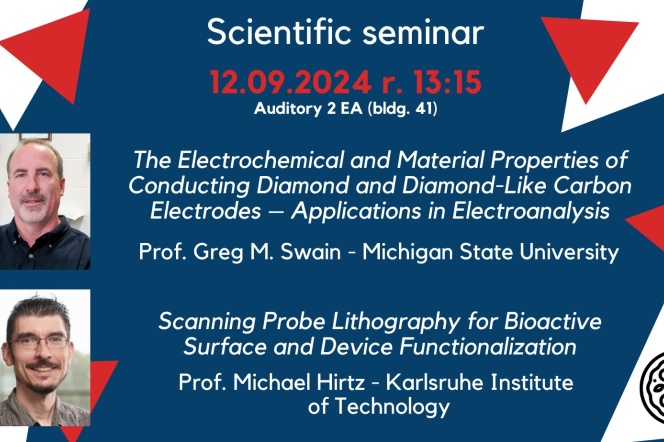Date added: 2024-08-26
The 23rd Seminar of Advanced Materials Center

We cordially invite you to the next, twenty-third seminar of the Advanced Materials Center, which will be held on Thursday, September 12, 2024, at 1:15 p.m. in Auditorium 2 EA (building 41, old ETI).
Prof. Greg M. Swain from the Department of Chemistry at Michigan State University, USA, will present a lecture entitled "The Electrochemical and Material Properties of Conducting Diamond and Diamond-Like Carbon Electrodes - Applications in Electroanalysis". Prof. Swain is an outstanding scientist specializing in the study of the kinetics of electrochemical processes. Swain Research Group (Swain Research Goup) fabricates various carbon materials and investigates toward application in neurochemical analysis, as sensory platforms, in environmental analysis or fuel cells.
Next, Prof. Michael Hirtz from Karlsruhe Institute of Technology will present a lecture entitled "Scanning Probe Lithography for bioactive surface and device functionalization". Prof. Hirtz is the Scanning Probe Lithography for Biomaterials and Bioelectronics group leader, which specializes in the development of nanolithographic techniques, also using biological materials and their application in molecular diagnostics.
After the lectures, we traditionally invite you to unofficial discussions and pizza!
Abstracts:
Scanning Probe Lithography for Bioactive Surface and Device Functionalization
Scanning probe lithography (SPL) techniques like dip-pen nanolithography (DPN), polymer pen lithography (PPL) and spotting with microchannel cantilevers (µCS) offer unique opportunities for highly-localized chemical surface functionalization with resolutions in the micron to even nanometer scales. All these techniques have unique strengths in terms of resolution, obtainable throughput and patterning speed and broad compatibility with delicate chemical and biological inks. Generally, they offer mild process parameters and are capable of multiplexing (i.e. deposition of different compounds within a desired micropattern). Hence, these methods are inherently of special interest for the generation of bioactive surfaces and biohybrid devices (i.e. devices combining conventional and biological materials) in biomedical applications.
We demonstrated the great utility of SPL methods for the generation of bioactive surfaces, biosensing applications, and in particular for deposition of biomimetic phospholipid membranes. In this talk, we will briefly introduce relevant SPL techniques and showcase some applications of lipid membranes in biohybrid devices and as platform for rapid capture of extracellular vesicles (EVs) for cancer diagnostics and other biomedical applications.
----
Greg Swain could not come to the 23th Seminar of AMC and he will give his speach online.

